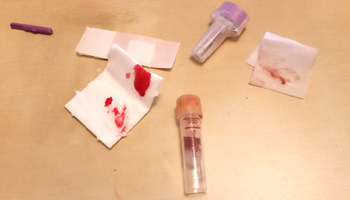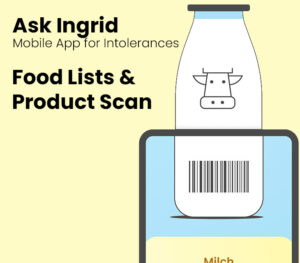Time and again I meet people who tell me that they also have a food intolerance. Not unusual given my job. Recently, I have noticed that more and more of the people I talk to have made their own diagnosis – with the help of a blood self-test or other home tests.
Home tests from the internet
Many have ordered a self-test on the Internet, carried it out at home, sent it by post and received their “diagnosis” a few days later. As I have been dealing with this topic professionally for over a decade, I am of course familiar with such tests and have long wanted to dedicate a blog entry to them. When I saw more and more advertisements for such IgG blood self-tests on the Internet and on social networks, it was time for me to put the plan into action. And now, after the company “Kiweno” received seven million euros for such self-tests in an Austrian start-up show (1), the topic has suddenly received a lot of press and is now also present in the major media (2, 3).
Self-tests with 4 tests
So I ordered some self-tests and then discussed the results with doctors and a dietician. I came across interesting details, discovered completely unexpected new aspects and learned a lot about people and marketing. I will report on this in detail in the coming blog entries.
I would like to start with the business models and my sampling.
The business of fear
I enter a few symptoms into Google and quickly find advertisements from home test manufacturers. When I was surfing the many different provider websites, I was surprised by the variety of test options. I was familiar with the Florastatus, gluten stool test and IgG blood test for food intolerances, but there are many other factors that can be tested. Hormone status, hair vitamin check, burnout or cancer test. The range is huge. The sales arguments are almost always the same: lose weight, live healthier, have more energy in everyday life, live healthier, have a more balanced lifestyle, live healthier. It seems to me that they like to play on the fear of people looking for answers and the desire for a “healthier life”. In reality, you’re not buying self-tests, you’re buying lifestyle. I choose four self-tests that I can compare with the values I know from my recent check-up or with my clinical allergy and intolerance tests. I want to approach the tests with an open and unbiased mind.
I order: An IgG4 test for over 70 foods, an IgE allergy test, gluten test stool and Florastatus stool. The purchase is done quickly, everything together costs me just under 400 euros.
My state of health
Briefly about my health data, which I now share with the world without any privacy concerns… I know that I am lactose intolerant and intestinal fructose intolerant. I am allergic to cat epithelia, house dust mite and grass pollen. My allergies and intolerances have been clarified very well. I definitely have no irritable bowel syndrome, no abdominal pain, no food allergies (not even cross-allergies), no histamine intolerance, no coeliac disease or other problems with gluten or grains. I tolerate all types of milk perfectly. Although… I can’t say anything about mare’s milk, which also appears in our lactose tables, as I have never drunk it. In short: I feel great, have my intolerances well under control and live completely symptom-free, unless I commit a “fructose sin”. But whoever is without fructose sin, throw the first stone fruit…
Testing
Stool tests – different disgust factors
After a few days, my tests arrive and I start taking samples. The stool tests are disgusting, but the sample collection is easy. A very small and above all flexible spoon is used to maneuver lumps of stool into a container. Sounds unappetizing, and unfortunately it is a bit unappetizing. As the spoon is very flexible, as I mentioned, I throw the odd lump of stool against the edge of the toilet. You get used to it.
Blood test with difficulties

The two blood tests are more difficult. Since it’s winter and I have rough hands, the first test (IgE) doesn’t work at all. I prick myself with the lancet, see a little blood and the wound is closed again. I am proud of my blood clotting, but since only two lancets are included, I now have to make myself bleed. I wash my hands again with warm water to improve the blood supply. The second stitch is a little better, but I can’t manage to fill the tube up to the mark with the best will in the world. I only send a half-full tube and hope that the test can still be carried out. I do the other blood test (IgG) a few days later. Interestingly, taking blood – with the same lancets – works perfectly, I don’t stop bleeding at all and could probably fill three tubes. First observation: taking blood from a doctor is easier. At home it’s like a bloodbath…
Sending samples is free of charge
I carry the chilled samples dutifully to the post office, according to the test description. I only put the IgG test – which I do a little later – in the letterbox. That’s ok, says the test description. But the letterbox is not emptied until the next evening and is left in the sun. I hope this doesn’t harm my test. However, the manufacturer’s website assures me that exposure to heat is not a problem and that the sample can even be kept for three weeks. Later, a lab doctor will explain to me that the letterbox would probably not be a good idea. It can get very hot there, especially in summer, and this is very likely to destroy some samples.
However. I am eagerly awaiting my results…
The results are in!
A few days after sending my samples, I receive the first results. The providers all have the same concepts. You send the samples by post free of charge and a few days later you receive your results by post or via the website. Usually paired with some kind of diagnosis or recommendations on what to do. However, with the exception of the IgG test, one recommendation is always the same: “Please discuss the results with a doctor or therapist”. Yes, that would certainly make sense. In my experience, most people do not discuss these results with their doctor, but post their sample evaluations in Facebook groups, where people – certainly not doctors or therapists – then interpret the results, give tips and suggest medications. It’s kind of logical… if I need a doctor for this, I could do the test with this doctor right away. Probably even free of charge… Then it’s better to pay for it and have it evaluated by non-experts in Facebook groups. But enough with the sarcasm, I’m curious to see what I came up with.
Sources
1) Forbes.at “Kiweno clears 7 million in 2 minutes”
2) Der Standard from 16.04.2016 | “Experts warn against test procedure of record start-up Kiweno”…
3) profil, No. 16/2016, “Negative findings” pp 70-73


